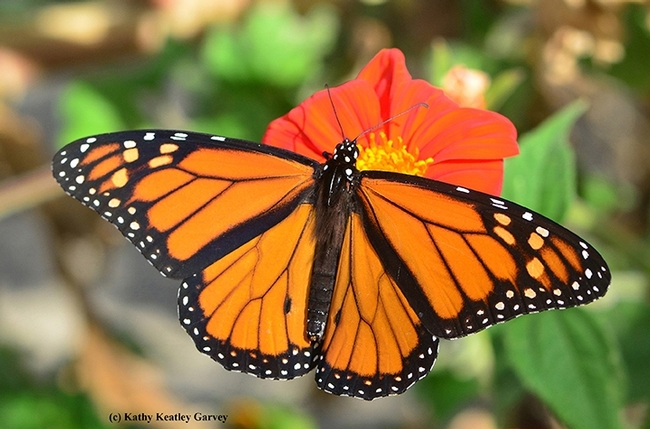- Author: Kathy Keatley Garvey
Newly published UC Davis research analyzing modern-day and museum collections of monarch butterflies over a 200-year period indicates that the loss of migration and range expansion leads to smaller and shorter wings.
The research, “Two Centuries of Monarch Butterfly Collections Reveal Contrasting Effects of Range Expansion and Migration Loss on Wing Traits,” appears this week in the Proceedings of the National Academy of Sciences.
“We measured the wings of 6,000 museum specimens of monarch butterflies collected from 1856 to the present, as well as contemporary wild-caught monarchs from around the world,” said lead author Micah Freedman, a former UC Davis doctoral candidate in population biology and now a postdoctoral fellow at the University of Chicago.
“The major implications of the research,” Freedman said, “are that it shows (1) loss of migration can affect the evolution of monarch butterflies over contemporary time scales--dozens to hundreds of years; and (2) monarchs with large forewings are better-suited for long distance movement, and this likely contributed to their global expansion over the past 200 years.”
Co-Authors of PNAS Paper
Freedman works closely with noted migratory animal authority and co-author Hugh Dingle, emeritus professor, UC Davis Department of Entomology and Nematology, who received a 2014 UC Davis Edward A. Dickson Professorship Award to research “Monarchs in the Pacific: Is Contemporary Evolution Occurring on Isolated Islands?” They co-authored the research with Sharon Strauss, professor and Santiago Ramirez, associate professor, Center for Population Biology and the Department of Evolution and Ecology.
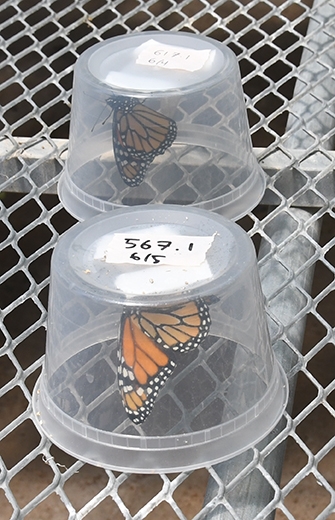
Their research documents how migration-associated traits may be favored during range expansion but disfavored when species cease seasonal migration. “Furthermore, it highlights the value of museum collections by combining historical specimens with experimental rearing to demonstrate contemporary evolution of migration-associated traits in natural monarch populations,” Freedman said.
Said Dingle: “At a time when museum collections are under pressure from a scarcity of funding, the results also show just how valuable such collections can be to evolutionary research and to the understanding of ongoing biological processes in the face of anthropogenic change.”
In their abstract, they pointed out that “migratory animals exhibit traits that allow them to exploit seasonally variable habitats. In environments where migration is no longer beneficial, such as oceanic islands, migration-association traits may be selected against or be under relaxed selection.”
“Monarch butterflies are best known for their continent-scale migration in North America but have repeatedly become established as non-migrants in the tropical Americas and on Atlantic and Pacific Islands,” they wrote. “These replicated non-migratory populations provide natural laboratories for understanding the rate of evolution of migration-associated traits.”
What They Determined
They determined (1) how wing morphology varies across the monarch's global range, (2) whether initial long-distance founders were particularly suited for migration and (3) whether recently-established non-migrants show evidence for contemporary phenotypic evolution.
Under controlled conditions in a UC Davis lab, they also reared more than 1000 monarchs from six populations around the world and measured migration-associated traits.
“Historical specimens show that initial founders are (1) well-suited for long-distance movement and (2) loss of seasonal migration is associated with reductions in forewing size and elongation,” they related. “Monarch butterflies raised in a common garden from four derived non-migratory populations exhibit genetically based reductions in forewing size, consistent with a previous study.”
Dingle said the findings “provide a compelling example of how migration-associated traits may be favored during the early stages of range expansion, and also the rate of reductions in those same traits upon loss of migration.”
Statistics show that the population of monarch butterflies in the United States has declined by 90 percent over the past 20 years.
Undergoing Contemporary Evolution
The monarch butterflies established just 200 years ago in remote Pacific Islands are undergoing contemporary evolution through differences in their wing span and other changes, Dingle said. He and Freedman studied monarchs in the Pacific Islands for a week in 2016 in a project funded by Dingle's UC Davis emeritus faculty grant, the Edward A. Dickson Professorship Award. The research involved measuring the wingspans of Guam monarchs to determine whether there has been an evolutionary decrease in size or shape due to their migration-free lifestyle on the island. They also measured the wings of monarchs in the University of Guam's museum collection.
An analysis of a monarch population in Hawaii shows that resident monarchs have shorter, broader wings than the long-distance migrants, Dingle noted. The Hawaii butterfly wings were shorter than the eastern U.S. long-distance migrants, but “not so short-winged as the residents in the Caribbean or Costa Rica, which have been present in those locations for eons, rather than the 200 years for Hawaii.”
Dingle, author of two editions of Migration: The Biology of Life on the Move (Oxford University Press), a fellow of the American Association for the Advancement of Science and a past president of the Animal Behavior Society, said previous studies by various authors revealed that migrant and long-resident monarchs exhibit different wing shapes. "Thus, it was desirable to examine populations with only short residency to see if the same phenomenon was evident.”
Dingle, who served as a UC Davis entomology professor from 1982 to 2002, achieving emeritus status in 2003, has engaged in research throughout the world, including the UK, Kenya, Thailand, Panama, Germany and Australia. National Geographic featured Dingle in its cover story on “Great Migrations” in November 2010. LiveScience interviewed him for its November 2010 piece on“Why Do Animals Migrate?”
The Bohart Museum of Entomology at UC Davis was among the 22 global museum collections studied. The research also included private collections and online databases. Freedman and assistant Christopher Jason reared some of the butterflies included in the PNAS paper in a UC Davis greenhouse.
The project drew funding from the National Science Foundation (NSF) Graduate Research Fellowship Program, the NSF East Asia and Pacific Summer Institute Program, the UC Davis Center for Population Biology, and the National Geographic Society to Freedman, as well as the Dickson Emeritus Professor Award to Dingle, a California Agricultural Experiment Station grant to Strauss, and a David and Lucille Packard Fellowship to Ramirez.
The abstract:
“Migratory animals exhibit traits that allow them to exploit seasonally variable habitats. In environments where migration is no longer beneficial, such as oceanic islands, migration-association traits may be selected against or be under relaxed selection. Monarch butterflies are best known for their continent-scale migration in North America but have repeatedly become established as non-migrants in the tropical Americas and on Atlantic and Pacific Islands. These replicated non-migratory populations provide natural laboratories for understanding the rate of evolution of migration-associated traits. We measured more than 6,000 museum specimens of monarch butterflies collected from 1856 to the present, as well as contemporary wild-caught monarchs from around the world. We determined (1) how wing morphology varies across the monarch's global range, (2) whether initial long-distance founders were particularly suited for migration and (3) whether recently-established non-migrants show evidence for contemporary phenotypic evolution. We further reared more than 1,000 monarchs from six populations around the world under controlled conditions and measured migration-associated traits. Historical specimens show that (1) initial founders are well-suited for long-distance movement and (2) loss of seasonal migration is associated with reductions in forewing size and elongation. Monarch butterflies raised in a common garden from four derived non-migratory populations exhibit genetically-based reductions in forewing size, consistent with a previous study. Our findings provide a compelling example of how migration-associated traits may be favored during the early stages of range expansion, and also the rate of reductions in those same traits upon loss of migration.”
As a postdoctoral fellow at the University of Chicago, Freedman said he is "currently using breeding experiments and DNA sequencing trying to figure out which genes affect migratory traits and behaviors in monarchs. This includes wing traits (shapes and size) discussed in the PNAS paper.”
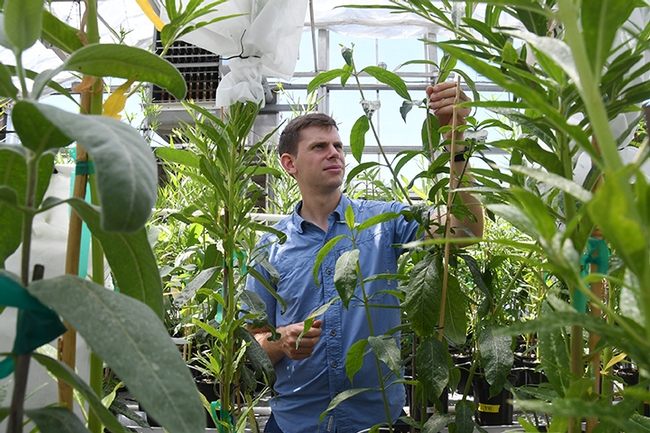
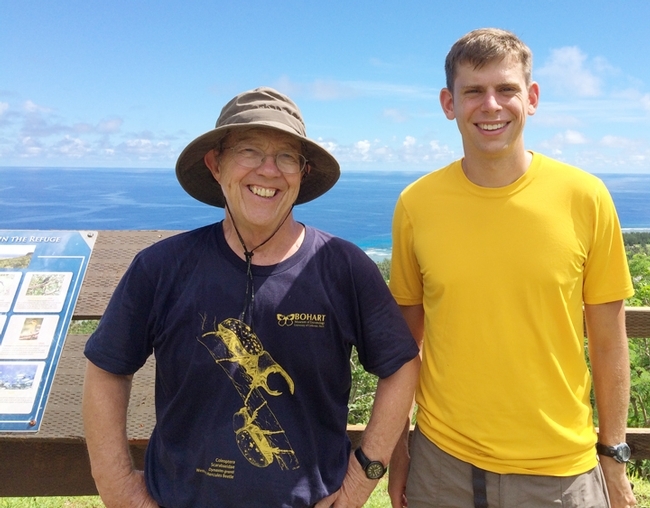
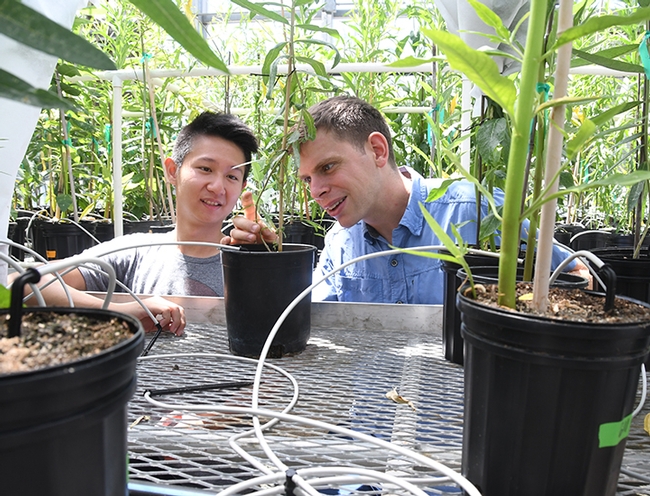
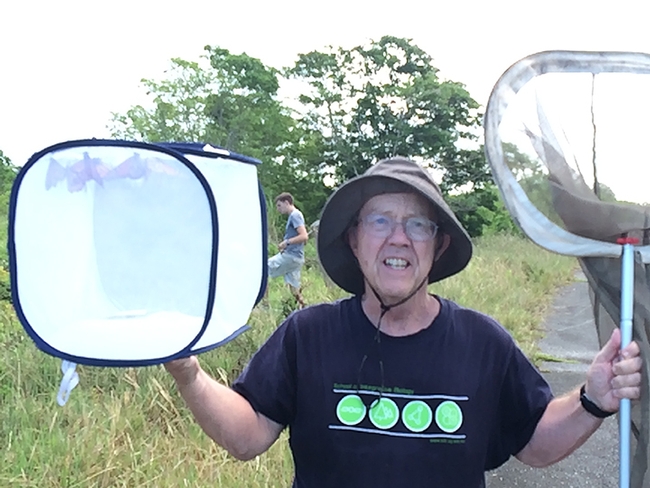
- Author: Kathy Keatley Garvey

The program, established in 2000 to honor the achievements of outstanding faculty members early in their careers, is funded in part by the Davis Chancellor's Club and the Annual Fund of UC Davis. Each will receive $25,000 for their research or other scholarly work and hold the title of "Chancellor's Fellow" for five years.
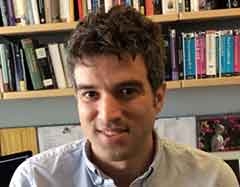
Ramirez, with the Department of Evolution and Ecology, College of Biological Sciences, is a global expert on orchid bees. He received his doctorate from Harvard. Ramirez is a frequent speaker at seminars and conferences affiliated with the UC Davis Department of Entomology and Nematology, including the UC Davis Honey and Pollination Center.
This year's list of Chancellor's Fellows:
- Christopher Barker, veterinary medicine
- Eleonora Grandi, medicine
- Jane Gu, electrical and computer engineering
- Erin Hamilton, sociology
- Maceo Montoya, Chicana and Chicano studies
- Santiago Ramirez, evolution and ecology
- Christopher Simmons, food science and technology
- Anne Todgham, animal science
- Aijun Wang, medicine
- Megan Welsh, education
- Nicolas Zyns, anthropology
The UC Davis Department of Entomology and Nematology has two current Chancellor's Fellows: Joanna Chiu (selected in 2019) and Neal Williams selected in 2015. (See list of Chancellor's Fellows)

- Author: Kathy Keatley Garvey

The seminar takes place from 12:10 to 1 p.m. in 122 Briggs Hall and will be hosted by one of his collaborators, Santiago Ramirez, assistant professor, UC Davis Department of Evolution and Ecology.
"Communication between the sexes by means of chemicals is widespread among insects including bees," Eltz writes in his abstract. "In most cases, bee pheromones are endogenous in the sense that they are produced from simple metabolic precursors. However, in the neotropical orchid bees (Apinae, Euglossini) the males have replaced endogenous pheromones by a wide range of environmental volatiles harvested from plants and other odoriferous sources in their habitat."
"Male orchid bees collect complex blends of volatiles in a way similar to 'enfleurage' of the traditional perfume industry, and later broadcast such 'perfumes' during courtship display," he says. "In my talk, I show how male orchid bees manage to accumulate chemically species-specific perfumes in variable odor 'markets,' shed light on the mechanisms and circumstances of perfume signaling, and discuss the evolutionary causes of perfume making."
Eltz studied biology at the University of Würzburg, Germany, and Duke University, Durham, N.C., with a focus on animal ecology and evolution. He received his doctorate at the University of Würzburg; his dissertation was on "Ecology of Stingless Bees (Apidae, Meliponini) in Lowland Dipterocarp Forests in Sabah, Malaysia, and an Evaluation of Logging Impact on Populations and Communities."
He has studied in Panama, Malaysia, Australia and Mexico, receiving fellowships or employed as a visiting scientist.
Plans are to record the seminar for later posting on UCTV seminars.
For the remainder of the UC Davis Department of Entomology and Nematology seminars, access this page.

